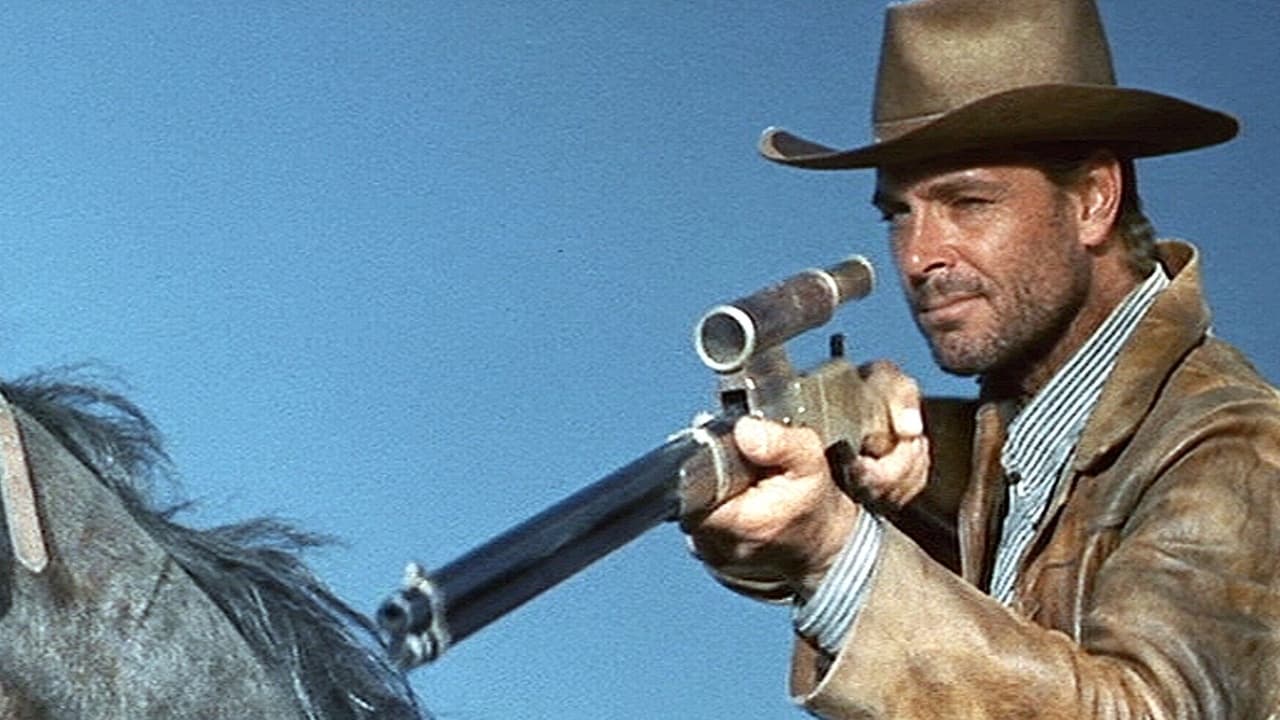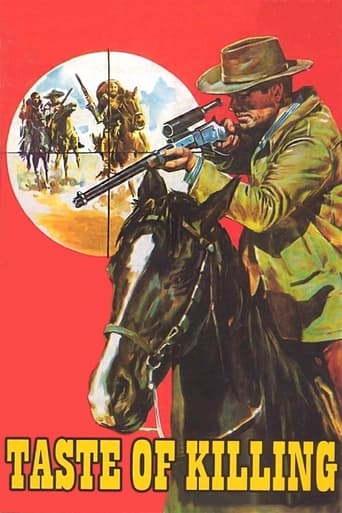

A TASTE OF KILLING is a low budget and generic spaghetti western made in the wake of the success of Sergio Leone's A FISTFUL OF DOLLARS. It stars the square-jawed Craig Hill as a supremely confident bounty hunter who makes a living from bumping off bank robbers until some money-men come up with a new mission for him: to stop a planned heist BEFORE it takes place.This movie is undistinguished by genre standards although there isn't really anything to dislike about it. Director Tonino Valerii would later go on to helm stylish efforts like MY NAME IS NOBODY and A REASON TO LIVE, A REASON TO DIE and it's clear he was finding his feet with this, his first movie. The familiar faces of Spanish star Fernando Sancho and George Martin (as the baddie) appear, and watch out for Chinese actor George Wang cast as a Mexican.The plot and characters are rather typical for this genre and there are few twists to keep you occupied. However, the cinematography at least makes it look good, and the various action scenes are well handled. What I particularly liked was the lead's proficiency with his sniper rifle, which leads him to take down various enemies at various points throughout the movie. It's a nice little addition to an otherwise uneven outing that's only suitable for die-hard genre fans.
... View MoreBounty Killer Craig Hill follows monetary shipments and rescues the money after they're robbed. After a typical job, he gambles his ten-thousand dollar reward on a double-or-nothing proposition involving himself protecting a gold cache. Trying to take the gold is George Martin, the bandit that killed Hill's brother some time before.A good enough Italian western, this has some decent action and suspense scenes, with Hill's character pulling off some excellent rifle work. Yes, it's derivative, but still pretty solid. The climax is well handled too.Director Tonino Valerii went on to make My Name Is Nobody, one of the best spaghetti westerns ever.Here, villainous Martin looks a bit like William Shatner, if he were cast as a Klingon!
... View MoreTonino Valerii's TASTE OF THE KILLING really is about as fine of a non-Leone spaghetti western as one can hope for. Craig Hill is very well suited for the role of a laconic, cynical and somewhat snarky bounty killer working one hell of a racket shadowing gold and currency shipments to and from various banks. Presuming holdups, he simply waits until one gang or another decides to make a grab for the loot, eliminates them, returns the shipment and collects a 10% commission on the return & cleans up on the inevitable bounty payments on the heads of the gang members. Beats working a day job.Things get interesting when his latest bounty gambit leads him into the town where the murderer of his brother (George Martin, unrecognizable in his makeup job) is leading the local pistolero gang who are waiting out a gold shipment they plan to hijack. Fat chance. Working with both the bank manager (Franco Ressel) and the owner of the local gold mine (Piero Lulli in a rare non-villain role), Craig Hill sets up a brilliant scam to insure his own protection of the shipment, wipe out the gang, clean up on the bounties, and follow the gold to it's next inevitable brush with another band of thieves who will inevitably have bounties on their heads, and start the whole thing all over again.The first hour or so is almost hypnotic in it's syncopation of dialog, action, cinema kinetics courtesy of genre regular Stelvio Massi, and a peppy, imaginative musical score by Nico Fidenco. If the surroundings look familiar to spaghetti western fans they should be, as the bulk of the film is set in & around Carlo Simi's leftover sets from FISTFUL OF DOLLARS and FOR A FEW DOLLARS MORE, which were literally good enough for a whole bunch of movies. The screen is also populated by a familiar cast of spaghetti and genre film regulars too: Fernando Sancho, George Wang, José Canalejas, Frank Braña, José Manuel Martín.The film had also found a chance to see both of Leone's movies too, serving as a distillation of certain themes which the brilliant Valerii found useful. Hill's use of a rifle with a telescopic sight combines the finesse of Eastwood with the technically adept Van Cleef as the camera literally repeats certain shots made famous to young filmmakers the world over after Leone's first two movies had become a sensation. But this film adds some interesting twists, such as the local lawmen inflicting the standard spaghetti western sadistic torture interlude onto one of the bad guys for a change in a scene that only works to underscore the film's ambiguous morality. The only honest people in the film are the ones with something to lose, who depend upon Craig Hill's talents even though he's a cold blooded killer.To his credit Valerii tries to inject a bit of humanity into the play by having a subplot about George Martin's villain with a heart of gold who wants to start a family with his girlfriend and young son. And it's here that the script takes a bit of a misstep by muddying up the proceedings with plot, though it does make Martin's villain into a sympathetic character -- perhaps even more sympathetic than the hero, which was probably the point. Then there's the big action climax with dozens of extras riding around raising dust and shouting while people get picked off from all angles. It all gets to be a bit too much for a stretch, the film's tightly woven ball threatening to unravel. Valerii picks up the pieces nicely in time for a taut, ingeniously photographed showdown scene, the film amusingly ending where it began with Hill watching another gang set up another robbery and you can just see the dollar signs in his eyes. Nice.7/10
... View MoreThis was SW notable Tonino Valerii's first directorial effort in the genre. The year before he had served as 2nd Unit Director on Sergio Leone's For A Few Dollars More, and the influence of that experience are obvious on this film. Much of the film was shot on sets from FAFDM and there are number of scenes - Lanky's shoot out with Sanchez is a perfect example - that match similar scenes in the second Dollars film almost shot for shot. As in that film, we spend a lot of time watching action from a distance through the (anti)hero's telescope. This is interesting because most of Valerii's western follow the model of his 2nd SW, Day of Anger, and are firmly in the Duccio Tessari/Ernersto Gastaldi 'school', which was very different from the Leone westerns. Their visual and narrative style is distinct and is often described as being more "traditional". The characters in these films tend to a little less cynical, more immediately sympathetic, though the films tend to be a bit hokier. A perfect example would be Arizona Colt (1966).The film is uneven, though it would be largely enjoyable for genre fans. The story involves the usual SW elements - wolves in sheep's clothing, ambushes, bank raids, ritualized gunfights, taciturn gunmen, and loud Mexican bandits. Craig Hill does a credible turn as a Clint Eastwood stand-in, though it is his characterization of Hank 'Lanky' Fellows that is one the most confused elements in the film. He actually ends up being more cynical than the Man With No Name, while the villain, Gus Kennebeck, is by turns more vile than Indio from FAFDM (as he tortures his brother with boiling coffee), then alternately sympathetic (through his relationship with his son and the son's mother). His motivations are more immediate than Fellows's, who repeats several times throughout the film that 'You can never have too much money'.There was a very good film in here somewhere in the Gothic family western manner that was flourishing in 1966-1968 (Return of Ringo, Texas, Adios, The Forgotten Pistolero) with it nasty infighting and violence between the two Kennebeck brothers - the one who as gone straight and dresses like a gringo, the other has become a brutal bandit leader. The bandit tortures the brother, then kidnaps his daughter as a hostage. Afterwards the gringo brother retaliates by abducting his young nephew. This baroque, dark story is roughly grafted onto a typical bounty hunter plot, which is grafted onto a double cross/fight for gold plot, which is grafted onto a revenge plot. All in all, there is really too much thrown in thus interesting ideas are not followed through while others are muted.The difference between the brothers, one a mine employee and the other a bandit, is an interesting feature of the film. Both are, if their last names are any indications, Anglo-American, the differences are not ethnic (given the limited amount of information in the film) but behavioral, contrasting mannerisms and dress. This is an interesting variation in the genre. The divide between bandit (usually played by Fernando Sancho or Tomas Milian) and gringo (Eastwood or Van Cleef) is usually indicative of a Northern Italy/Southern Italy opposition (think of Tuco and Blondy in The Good, The Bad, And The Ugly) or of a First World/Third World divide. In this film, the differences appear to have been largely superficial one - essentially through costume - that indicates inner conditions, in a quasi-White Hat v. Black Hat fashion, though a little more complex perhaps. Or perhaps it is the familiar trope of the one brother who has "made good" and the conflict between him and those he had "left behind" and, in essence, repudiated. The gringo brother had changed his name, which may indicate this sort of story line. In some films the Mexicans are the heavies, in others (The Big Gundown or Vengeance Trail for example) the Anglos are. The use of this opposition in the different films is always interesting, varied, and rarely constant.It is interesting to note that Craig Hill's vengeance seeking bounty hunter seems to foreshadow Bronson as Harmonica in Once Upon A Time In The West.The score by Nico Fidenco is fairly good. One of the best moments in the film, as is often the case in the SW, is the long credits sequence. A rider appears silhouetted on a dark horizon, the sun just rising at the center of the frame. The rider slowly comes closer, passes in front of the sun, creating a nice "flash effect". As he rides up to camera a goofy theme song accompanies about the dangerous powers of one 'Lanky Fellers'. Good stuff. Then the animated credits start, accompanied by the instrumental version of the theme song.Another great moment is the final gunfight, which is handled well.In Bury Them Deep (All'ultimo sangue, 1968 ), another Craig Hill vehicle (and also scored by Fidenco), the footage of the bank raids was reused, though the context was completely changed which, with some minor editing, completely reversed the situation portrayed. The robbers in the one film become the robbed in the next!Though Valerii would develop his own personal approach to the genre, his last western was made again in connection with Leone who served this time as producer - My Name Is Nobody. This film matches Leone's style so much that there is constant speculation as to how much of the film Valerii is responsible for and how much was the result of the producer's involvement.Top spaghetti western list http://imdb.com/mymovies/list?l=21849907Average SWs http://imdb.com/mymovies/list?l=21849889For fanatics only (bottom of the barrel) http://imdb.com/mymovies/list?l=21849890
... View More